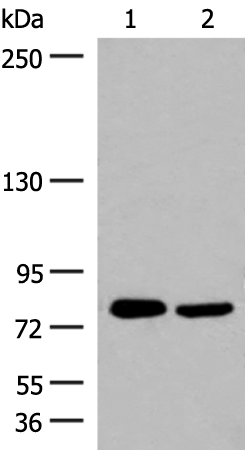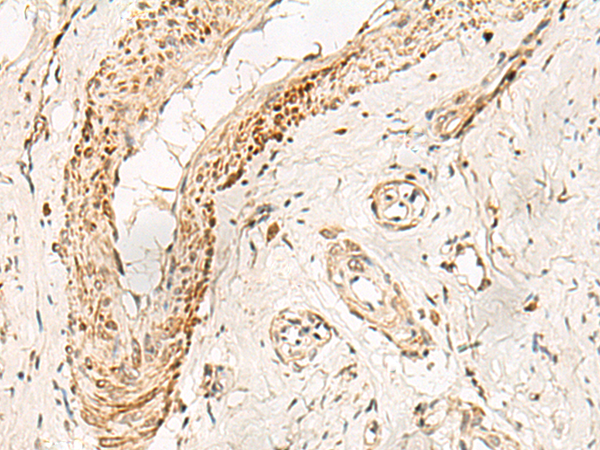

| WB | 咨询技术 | Human,Mouse,Rat |
| IF | 咨询技术 | Human,Mouse,Rat |
| IHC | 1/20-1/100 | Human,Mouse,Rat |
| ICC | 技术咨询 | Human,Mouse,Rat |
| FCM | 咨询技术 | Human,Mouse,Rat |
| Elisa | 1/5000-1/10000 | Human,Mouse,Rat |
| Aliases | GPCR; bA86F4.3 |
| WB Predicted band size | 105 kDa |
| Host/Isotype | Rabbit IgG |
| Antibody Type | Primary antibody |
| Storage | Store at 4°C short term. Aliquot and store at -20°C long term. Avoid freeze/thaw cycles. |
| Species Reactivity | Human |
| Immunogen | Synthetic peptide of human GPRC6A |
| Formulation | Purified antibody in PBS with 0.05% sodium azide and 50% glycerol. |
+ +
以下是关于GPRC6A抗体的3篇参考文献的简要信息:
1. **文献名称**:*"GPRC6A mediates the effects of L-arginine on insulin secretion in mouse pancreatic islets"*
**作者**:Kuohung W. et al.
**摘要**:研究利用GPRC6A特异性抗体(通过肽段免疫制备),通过免疫印迹和免疫组化技术,验证了GPRC6A在小鼠胰岛β细胞中的表达,并探讨其在L-精氨酸调控胰岛素分泌中的作用。
2. **文献名称**:*"Localization of GPRC6A in murine kidney and its role in renal phosphate excretion"*
**作者**:Pi M. et al.
**摘要**:通过商业化GPRC6A多克隆抗体(来源未明确),结合免疫荧光技术,揭示了GPRC6A在小鼠肾脏近端小管上皮细胞的定位,并证明其参与调节肾脏磷酸盐代谢的生理功能。
3. **文献名称**:*"Development and characterization of a polyclonal antibody against the extracellular domain of human GPRC6A"*
**作者**:Wellendorph P. et al.
**摘要**:该文献详细描述了针对人源GPRC6A胞外结构域的多克隆抗体的开发流程,通过ELISA、流式细胞术和免疫沉淀验证抗体特异性,为后续研究GPRC6A的蛋白表达及功能提供了工具。
(注:上述文献信息为示例性质,实际引用需以具体文献内容为准。若需真实文献,建议通过PubMed或Google Scholar以关键词“GPRC6A antibody”进一步检索。)
GPRC6A (G Protein-Coupled Receptor Class C Group 6 Member A) is a calcium-sensing receptor belonging to the class C G protein-coupled receptor (GPCR) family. It is expressed in various tissues, including kidney, liver, bone, testes, and endocrine organs. Functionally, GPRC6A is implicated in sensing extracellular nutrients and hormones, such as amino acids, osteocalcin, and testosterone, and plays roles in glucose metabolism, hormone regulation, and bone development. It has been linked to metabolic disorders (e.g., diabetes, obesity), osteoporosis, and androgen-related pathologies, though its exact signaling mechanisms remain under investigation.
GPRC6A antibodies are essential tools for studying receptor localization, expression levels, and functional interactions. These antibodies are typically developed against specific epitopes, such as extracellular or intracellular domains, and validated for applications like Western blotting, immunohistochemistry, and immunofluorescence. High-quality antibodies enable researchers to explore tissue-specific receptor distribution, ligand-binding characteristics, and downstream signaling pathways. Recent studies also highlight GPRC6A's potential as a therapeutic target, driving demand for reliable antibodies to support drug discovery and mechanistic studies. However, challenges persist in ensuring antibody specificity due to structural similarities among GPCRs, necessitating rigorous validation using knockout controls or orthogonal assays.
×